

On October 10th, we marked World Mental Health Day by launching Archinect's 2024 Mental Health Survey. Over 120 people participated, sharing their experiences of the past year, where mental health issues are arising from, and what steps they are taking to improve their own mental health.
This year’s survey results reveal both progress and persistent challenges. While 2023 highlighted an increasing awareness and openness about mental health, the 2024 findings emphasize a continued struggle with stressors such as workload, compensation, and burnout. Notably, the stigma around mental health discussions has further diminished, with many participants reporting improved comfort in seeking support. However, the data also underscores significant gaps in institutional resources and support systems.
Compared to last year, the community shows incremental improvements in mental health metrics, with a higher proportion of respondents ranking their mental health above average. Yet, the ongoing pressures of work-life balance, economic uncertainty, and professional demands remain dominant themes, mirroring concerns from 2023. A recurring trend from both years is the strong link between career dissatisfaction and mental health, with over half of respondents contemplating leaving the field due to stress.
Below, we list 11 key takeaways from our 2024 survey, detailing where mental health issues arise within the architectural community, how supported the community feels, how they think about the future, and how they plan to respond.
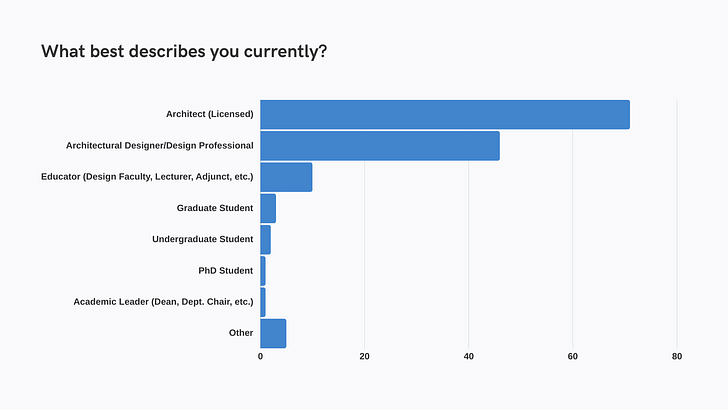
Out of the 122 people who participated in our 2024 survey, 57% were licensed architects, representing a majority of respondents. The second largest grouping was ‘Architectural Designer / Design Professional’, representing 37% of respondents.
Meanwhile, 8% of respondents answered under the group ‘Educator (Design faculty, lecturer, adjunct, etc)’ while 3% were graduate students. The remaining participant groups included undergraduate students, PhD students, academic leaders, practice office managers, director of operations, and marketing.
The gender composition of our 2024 survey mirrored that of our 2023 survey, with 66% of respondents identifying as male. 32% identified as female, with 2% preferring not to say. While this breakdown is not reflective of the U.S. population, it is broadly in line with industry data showing that 73% of U.S. architects are male and 27% are female.
The age breakdown of the survey was diverse, with the largest age range being 35–44, comprising 36% of respondents. The next largest was 45–54, comprising 24% of respondents, followed closely by 25–34, comprising 21% of respondents. The remaining age groups were 55–64 (14% respondents), 65+ (3% respondents), and 18–24 (2% respondents).

Respondents were asked to rate their mental health on a scale of 1 to 10, with ‘1’ being worst and ‘10’ being best. The largest share of responses was ‘8’ being chosen by 19% of respondents, followed by ‘7’ at 18% and ‘6’ at 15%. Overall, 52% of respondents rated their mental health as ‘7’ or above, while 67% rated their mental health in the top half of the scale (‘6’ or above).
“I am on the upswing after several difficult years when I was challenged personally and professionally,” one respondent told us, while another explained: “The older I get, the more tools and awareness I have for my mental health. Maybe it's different, but maybe it's the same — what seems different is my ability to handle my mental state.”
While mental health scores in the above scale lean positive, 92% of respondents report that stress from their profession and studies has negatively impacted their personal lives. A majority of respondents shared further details with us on how their architectural career is negatively impacting their mental health.
Many highlighted increased workloads, insufficient support, and toxic environments as detrimental factors. Some respondents noted that evolving responsibilities and management expectations contribute to heightened stress, while others cite job insecurity, lack of career progression, and inadequate financial compensation as ongoing sources of strain.
I feel like the amount of work and the responsibility takes my nerves to maximum height mainly because the amount of money available is very low compared with the work done. — Archinect survey respondent
“Working hours have generally decreased over the past ten years improving stress levels,” said one architectural designer (35–44) who scored their mental health as ‘8’ on our scale. “However, as my role and responsibilities have evolved, I exert increased stress and mental load on issues including HR and managing or assisting with issues faced by staff members.”
“I feel like the amount of work and the responsibility takes my nerves to maximum height mainly because the amount of money available is very low compared with the work done,” a 35–44 licensed architect explained, who gave a ‘5’ score, while a 55–64 licensed architect who gave a ‘3’ score noted, “Client and designers have greater expectations in terms of instant gratification.”
Though less frequent, some responses were more positive, highlighting improvements in mental health due to therapy, better work-life balance, leaving toxic environments, and personal growth.
“I have been taking the time to work out the last couple of years and that has really helped overall,” a 35–44 licensed architect who scored their mental health as a ‘9’ told us, while another licensed architect with an age range of 45–54 and a mental health score of ‘9’ shared: “The older I get, the better I can deal with things that were difficult for me in the past.”

Our survey asked respondents to identify the biggest issues impacting their mental health. A majority of respondents (68%) noted it was ‘balancing between the demands of work and home.’ A slim majority noted ‘uncertainty about the future’ and ‘economy’ as affecting their mental health, with other major issues being ‘politics,’ ‘social life/work culture,’ and ‘health.’ These top six issues were also the top six issues cited by respondents to our 2023 mental health survey.
“Architecture makes unreasonable demands on workers and their families for mediocre compensation in service of poor if any ideals and/or service to broader community and world,” one respondent told us while another noted, “Things continually get worse every year regarding quality of life and wages.”
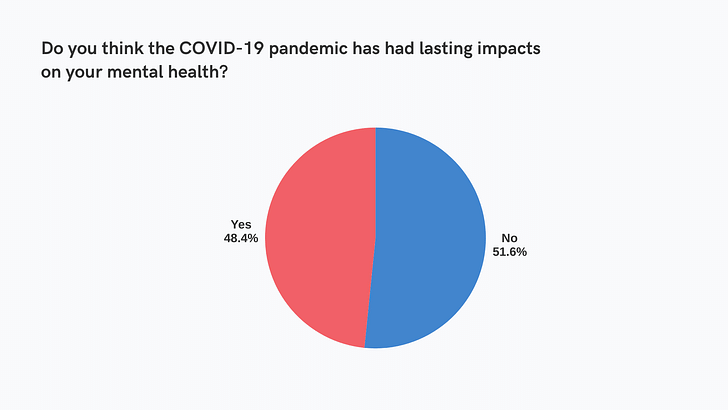
48% of survey respondents told us that the COVID-19 pandemic has had a lasting impact on their mental health, mirroring the findings of our 2023 survey. As our editorial has recently reported, the COVID-19 pandemic continues to exert a residual impact across the profession, contributing to business volatility, an unpredictable future for certain typologies, and changes in the design strategies for workplace projects.
“COVID lockdowns wiped me out,” one respondent noted. “The time since then has been much better.” Meanwhile, another respondent told us that “the pandemic, remote work, rapidly changing technology, and increased, often unrealistic, client demands come to mind,” while another shared: “It’s like we learned nothing from the pandemic with regards to working from home. I'm over it, and I know I'm not the only one. Life is so short.”
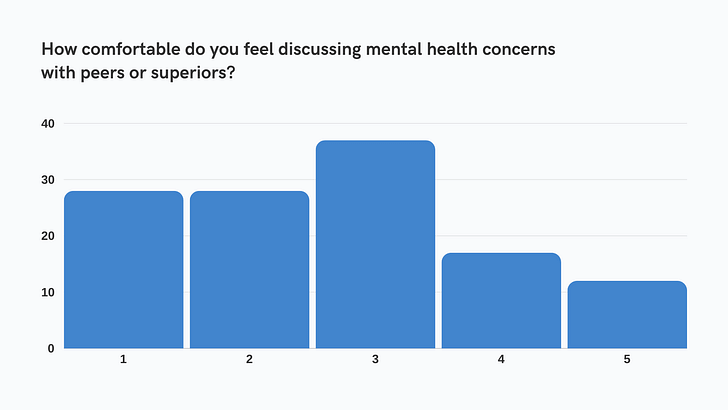
We asked respondents how comfortable they would be discussing mental health concerns with peers or superiors, with ‘1’ being least comfortable and ‘5’ being most comfortable. The single largest share of responses scored ‘3’, at 30%. However, 23% of respondents returned the lowest score, with only 10% returning the highest score. Overall, 76% of respondents returned a score of ‘3’ or below; figures which are worse than those from our 2023 survey.
“There is an absolute stigma regarding mental health,” one respondent told us. “We need to hear stories of people who have overcome or are working through their difficulties. Normalize it! Because it’s normal.”
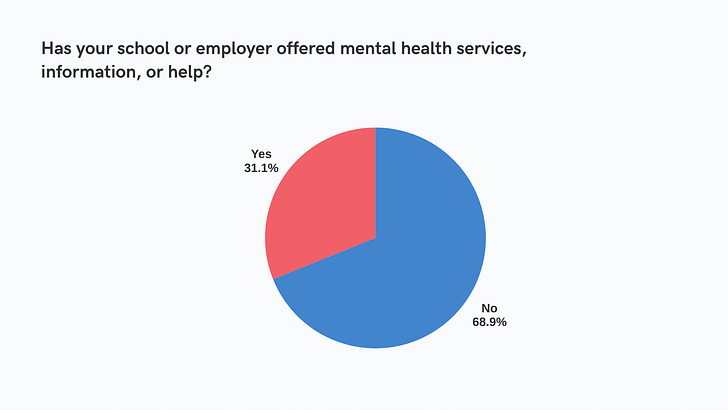
While most respondents expressed discomfort in discussing mental health concerns, a significant majority (69%) report that their school or employer does not offer mental health services, information, or help to facilitate such discussions. The findings are largely in line with our 2023 survey and also correlate with findings from our recent licensure survey that also found a lack of perceived support in the workplace and school studies for licensure candidates.
“There needs to be more transparency, empathy, and understanding when it comes to mental health,” one respondent told us. “I expressed to my employer that I had been experiencing depression and anxiety, and had been working on getting a handle on it, but that did not seem to matter to them.”
“As an employer, it is difficult to help younger generations with their personal struggles,” another respondent noted. “Their mental health from school or family traumas affects work, gets exacerbated by it, and it becomes a vicious cycle. It is hard for employees to be in charge of the mental health of staff when they are not engaged or ask for resources or opportunities.”
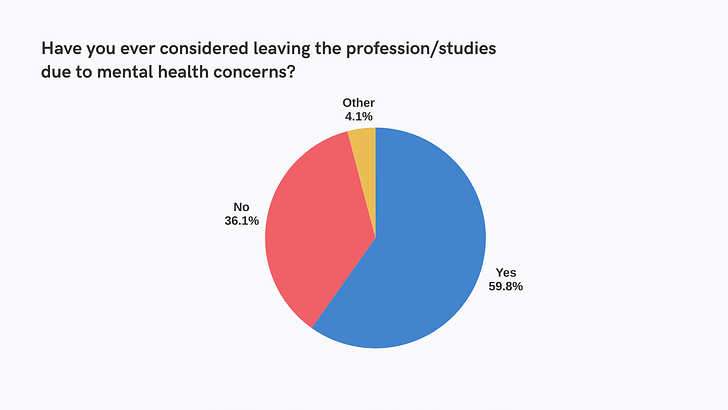
60% of respondents from our survey told us that they have once considered leaving the profession or their studies due to mental health concerns. This figure is a slight increase on our 2023 survey, where 57% of respondents expressed similar sentiments.
“I am a woman in my late thirties with a partner, and I would much rather prioritize having and nurturing a family than meeting a constant revolving door of deadlines,” one respondent told us. “I am over it and don't have the luxury of time to work late all the time like I did in my twenties, nor would I want to.” Meanwhile, another told us they will “quit work altogether if working hours are not reduced.”
We asked respondents to expand on their thoughts and/or concerns for the future, leading to responses that predominantly reflected uncertainty and worry. Chief among the concerns were economic stability, workplace conditions, and broader societal issues.
Many participants expressed concerns over job security, insufficient wages, and the financial challenges of balancing personal and professional responsibilities. Several worry that architecture, as a profession, is underappreciated and poorly compensated despite its demands, with some contemplating leaving the field altogether.
“Far too many poorly managed and toxic work environments,” a 45–54-year-old licensed architect told us. “Junior and mid-level staff are treated as disposable.” A 35–44-year-old licensed architect added that “architects are not on the good side of the economic inequality gap.”
Architects are not on the good side of the economic inequality gap. — Archinect survey respondent
Broader societal concerns, such as political instability, climate change, and the growing economic divide, weigh heavily on respondents. They highlight the architecture industry’s inadequate response to environmental issues and its susceptibility to economic downturns. Many feel the profession needs to modernize, particularly in its treatment of workers, lack of diversity, and outdated practices.
“Political instability and climate change are the two factors impacting me the most,” a 55–64-year-old licensed architect told us. “The continued downward spiral of institutions to deal with the pressing matters and our seeming helplessness to do anything about these issues.”
On a personal level, respondents cited the difficulty of maintaining a work-life balance, planning for retirement amid financial insecurity, and supporting their families.
“Everything looks dire; Everything,” a 35–44-year-old licensed architect told us. “But I have 3 children, and they need to have a future. I want there to still be a society in place for my grandchildren.” A 45–54-year-old licensed architect added, “I am concerned about being able to save for retirement.”
I'm hoping that the economy continues to do well so construction projects can continue, providing work for architects. — Archinect survey respondent
However, a minority of respondents express cautious optimism about potential improvements in design practices, personal growth, or evolving roles in the industry. Despite the challenges, some maintain a hopeful outlook, emphasizing the need for systemic change to secure a sustainable and equitable future for the profession and its practitioners.
“I'm hoping that the economy continues to do well so construction projects can continue, providing work for architects,” a 45–54-year-old licensed architect told us, while a 35–44-year-old licensed architect told us they were “optimistic about the economic future, uncertain about environmental issues, and hopeful about my evolving design roles.”
To conclude our survey, we asked respondents to share what practices, methods, or resources they have used to maintain a positive outlook or reduce anxiety. Participants shared a variety of practices, with the most common being therapy, exercise, and setting clear boundaries between work and personal life.
Activities such as meditation, yoga, hobbies, and spending time outdoors or with family were frequently mentioned for promoting mental well-being. Several respondents highlighted the importance of spiritual practices like prayer, while others turned to self-care routines, including massages, spa visits, and engaging in creative hobbies.
Some respondents emphasized workplace adjustments, such as leaving toxic environments, refusing overtime, and maintaining a separation between work and home life. Others noted the positive impact of travel, social connections, and exploring side projects unrelated to work. Recreational activities, such as video games and social events, were also cited as helpful for reducing stress.
Further advice on improving and maintaining positive mental health can be found in our recent feature articles on overcoming and preventing burnout, reducing the stress of an architecture job search, and reducing stress if you are worried about your current position.
Join the conversation, and share your personal experience in the comment section below.
Niall Patrick Walsh is an architect and journalist, living in Belfast, Ireland. He writes feature articles for Archinect and leads the Archinect In-Depth series. He is also a licensed architect in the UK and Ireland, having previously worked at BDP, one of the largest design + ...
No Comments
Block this user
Are you sure you want to block this user and hide all related comments throughout the site?
Archinect
This is your first comment on Archinect. Your comment will be visible once approved.